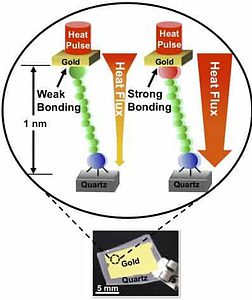Scientists have described and proven how many of the world’s phenomenae function, from the very fundamental laws of Newtonian mechanics, to the discrete behaviors of quantum physics, eventually peering through some of the Universe’s most well kept secrets. It’s remarkable then, how little we know about how heat is conducted through and between materials. A better understanding of heat transfer, starting from the discrete level, might hold dramatic consequences for the better. Heat exchange and interaction is a constant process which occurs everywhere around us, as thermal balance is sought by nature.

“Heat travels through electrically insulating material via ‘phonons,’ which are collective vibrations of atoms that travel like waves through a material,” said David Cahill, a Willett Professor and the head of materials science and engineering at University of Illinois. Compared to our knowledge of how electricity and light travel through materials, scientists’ knowledge of heat flow is rather rudimentary.
Cahill and colleagues at the University of Illinois used a combination of ultra-fast, sensitive measuring system and atom-size layers of materials arranged in a certain manner to reveal some extremely interesting insights about how heat flows across an interface between two materials.
The main reason why heat flow is so poorly understood is because it’s very difficult to observe and measure at the nanoscale and over extremely short time spans. In an attempt to devise an experimental setup towards heat flow study, the scientists used a laser beam to fire very short bursts lasting only a trilinth of a second to probe through heat flow dispersed over a nanoscale “molecular sandwich”, as described by the paper’s authors.
The researchers first arranged a thin quartz surface, over which they coated it with a single layer of molecules. Again, another thin layer of gold had been placed on top of the latter. They then fired a heat pulse to the gold film and measured how it conducted through the sandwich assembly. The scientists conclude that simply by altering the molecular composition of the atom-sized layer placed between the two materials, a dramatic shift in heat transfer occurs, all depending on how strong the bonds between the gold and intermediate layer molecules are. In various instances, the researchers demonstrated that stronger bonding produced a twofold increase in heat flow.
“This variation in heat flow could be much greater in other systems,” said Mark Losego, who led this research effort as a postdoctoral scholar at Illinois and is now a research professor at North Carolina State University. “If the vibrational modes for the two solids were more similar, we could expect changes of up to a factor of 10 or more.”
The scientists’ findings open a whole new realm of research, one which might rend some extremely fruitful advancements, especially for electronics where integrated circuit heat transfer is of great concern, combustion engines, furnaces, thermal insulating material science and so on.
“For many years, the physical models for heat flow between two materials have ignored the atomic-level features of an interface,” Cahill said. “Now these theories need to be refined. The experimental methods developed here will help quantify the extent to which interfacial structural features contribute to heat flow and will be used to validate these new theories.”
via Eureka Alert



